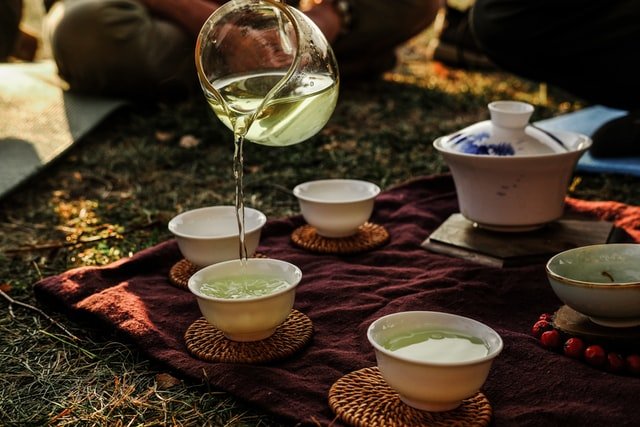
Green tea is the king of beverages in many Asian countries. Its consumption began in China thousands of years ago and spread with Buddhism to neighboring countries such as Korea or Japan.
Tea was initially considered a medicinal drink and was intermingled with the culture and traditions of these countries. It later reached the West through trade routes such as the famous Silk Road.
The world of green teas is rich and complex. In this article, we will tell you everything about it, from its production to the best way to prepare a cup at home.
The taste of green tea
Let’s start with the basics, the aromas and flavors. The family of green teas is the largest in the world of teas. There are literally hundreds of varieties.
Encompassing all this wealth in a description is not easy. In general, we can say that green tea stands out for its vegetable aromas. Scents like hay, grass, flowers, and fruit are often used to describe them. Its body tends to be light if we compare it with other teas such as black, although there are exceptions such as matcha, creamy and dense.
Green teas are often said to be refreshing and palate-cleansing. This is because a mild astringency and measured bitterness are common, which, together with its light body, make green tea easy to drink.
Green tea varieties
We have already told you, there are many factors such as the cultivation soil, the climate, the type of plants, the harvest time and innumerable variations in the elaboration method mark the character of each tea.
Japanese green tea
In Japan, green tea is by far the most consumed variety. In fact, almost all of its production is, precisely, from this tea. Let’s see below the possibilities when drinking Japanese green tea:
- Matcha: it is, perhaps, the green tea most related to Japanese culture since it is used in the famous tea ceremony. It is obtained by grinding tea leaves into a bright green powder that is consumed along with the infusion.
- Gyokuro: This is a mild tea with a peculiar aroma reminiscent of nori seaweed. Its peculiarity? Tea plants are covered to limit sunlight, so the leaves do not produce as many catechins and therefore do not have as much astringency as other varieties.
- Sencha: Without a doubt, it is the most consumed tea in Japan. It stands out for its dark green color in the cup and its vegetable flavor.
- Genmaicha: This variety is produced by blending green tea with roasted rice grains. Thus, its flavor is herbal with a hint of popcorn.
Chinese green tea
China produces about two tons of green tea every year. Although each of the varieties has a particular flavor, in general, Chinese tea has a sweet taste and an aroma reminiscent of roasted or dried fruits. Among its varieties we find:
- Longjing or dragon well tea: it is a vegetable infusion with a mild flavor with hints of toasted rice.
- Biluochun: Has a floral aroma and a mild, fruity flavor.
- Huangshan Maofeng: this infusion is sweet and stands out for its golden color in the cup.
- Lu’an Gua Pian: floral flavor and fresh aroma.
Korean green tea
The Korean brewing method combines Chinese and Japanese techniques. In this way, steam the leaves to later toast them. Among its varieties, the Ujeon stands out, an aromatic and fruity tea; the Jeoncha, with a mild and vegetable flavor; and Sejak, Korea’s traditional tea.
Of course, there are other green tea producing countries and large consumers outside of Asia. In Morocco, for example, they drink the emblematic Moorish tea, which is a gunpowder green tea often sweetened to the extreme.
Green tea production
Green tea is made, like the rest, from the leaves of the tea plant, Camellia sinensis; however, it undergoes a shorter oxidation process than other varieties, such as black tea. For this reason, it has a greater amount of polyphenols, substances with antioxidant effects that can protect the body from different chronic diseases and premature aging.
During the oxidation phase, and unlike what happens with the leaves harvested for black tea, they are not left to wither at room temperature, but are almost immediately subjected to a drying process.
This process varies depending on the country where production takes place. In Japan, for example, the leaves are placed in large bamboo trays over boiling water and steamed.
On the contrary, in China, “green is killed”; that is to say, the leaves are roasted in large woks placed over bonfires. These two cooking methods stop the natural oxidation of the leaves and preserve their properties to a greater extent.
Once cooked, the leaves are rolled so that they keep their essential oils, as well as all the flavor and aroma.
Health benefits of green tea
The most famous benefit of green tea is its weight loss properties. Different studies have indicated that green tea increases thermogenesis, the body’s process involved in burning fat. In addition, its content of catechins would help the liver to better synthesize fats, preventing them from accumulating in the body.
On the other hand, as we have already pointed out, green tea has antioxidant substances that protect the body from different diseases by fighting free radicals that generate oxidative stress. These diseases include cancer, cholesterol, and diabetes.
But that is not all. The L-theanine present in green tea exhibits relaxing properties that, according to some animal studies, may reduce anxiety and depression.
Did you know that green tea has antibacterial properties? For this reason, drinking a cup of green tea regularly might protect your teeth from cavities, by fighting the bacteria that cause them.
As you can see, green tea is a drink that can help take care of your health. However, it also has contraindications. For example, its consumption is not recommended during pregnancy and lactation, as well as for people who have problems with insomnia and hypertension due to its caffeine content.
How to prepare green tea at home?

Brewing a good cup of green tea at home is not difficult. However, green tea is more delicate than other varieties and you must take into account some recommendations to prevent it from becoming bitter.
To begin with, you should expect between 2 and 4 g of tea per cup. This amount varies according to the green tea you have chosen.
Second, it is very important that you do not boil the water. Heat it to 85°C since, being a less oxidized tea, it is more delicate to heat. An excess of temperature could make it noticeably bitter.
Another point to take into account is the duration of the infusion. Just as we told you that very hot water can ruin green tea, a very long infusion could also develop bitterness. Let the tea steep for 30 seconds to 2 minutes maximum.
Now that you know everything about green tea, you have no excuse not to prepare it at home. Cheer up, you will see how the whole family enjoys its delicious flavor, in addition to benefiting from its health properties.
